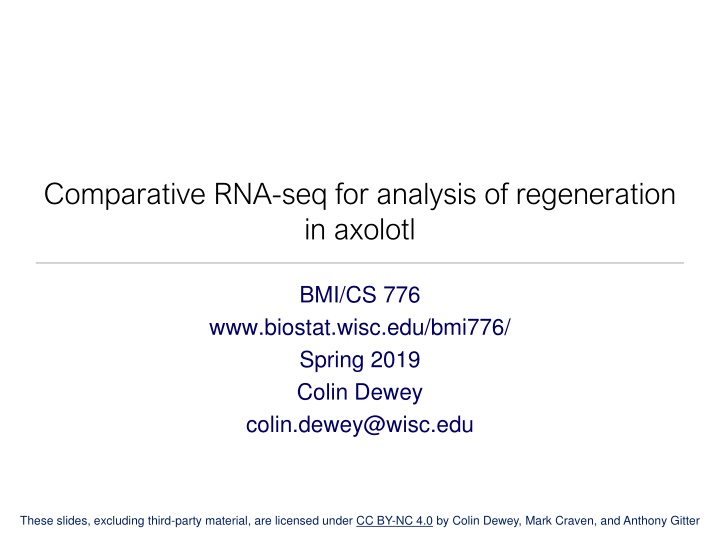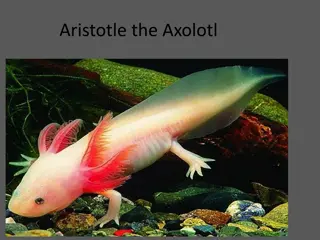
Comparative RNA-seq Analysis of Axolotl Regeneration
Explore the genetic basis of axolotl limb regeneration through comparative RNA-seq analysis, aiming to uncover the responsible genes and potential medical applications. Despite the challenges posed by the lack of a genome sequence and limited data, studies have shown promising insights into the regenerative abilities of this neotenous amphibian species.
Download Presentation

Please find below an Image/Link to download the presentation.
The content on the website is provided AS IS for your information and personal use only. It may not be sold, licensed, or shared on other websites without obtaining consent from the author. If you encounter any issues during the download, it is possible that the publisher has removed the file from their server.
You are allowed to download the files provided on this website for personal or commercial use, subject to the condition that they are used lawfully. All files are the property of their respective owners.
The content on the website is provided AS IS for your information and personal use only. It may not be sold, licensed, or shared on other websites without obtaining consent from the author.
E N D
Presentation Transcript
Comparative RNA-seq for analysis of regeneration in axolotl BMI/CS 776 www.biostat.wisc.edu/bmi776/ Spring 2019 Colin Dewey colin.dewey@wisc.edu These slides, excluding third-party material, are licensed under CC BY-NC 4.0 by Colin Dewey, Mark Craven, and Anthony Gitter
Some motivation Axolotl James Thomson Ron Stewart Regenerative Biology Laboratory, Morgridge Institute for Research, Madison, WI
Axolotl limb regeneration David Gardiner - HHMI-UCI
Goals What are the axolotl genes that are responsible for this remarkable regenerative ability? Can this knowledge improve our medical treatments of severe wounds and tissue regeneration?
Axolotl background Ambystoma mexicanum Neotenous Natural habitats Regenerative abilities Lake Xochimilco (canals) Limbs Lake Chalco (drained) Portions of Heart Endangered Portions of Brain Commonly sold as pets Tail and spinal cord
Challenges with genomic studies of Axolotl No genome sequence available genome estimated to be 10x larger than that of human 340 mya Distantly related to other model organisms 280 mya Villiard et al. 2007
Prior gene expression studies in Axolotl Microarrays Exist, but not very complete Limited amount of mRNA sequence data from Axolotl No genome, so can t use predicted gene sequences
Axolotl experimental setup Samples Stylopod (upper arm) (3) Zeugopod (lower arm) (3) Autopod (hand) (3) Digits (3) 30 day blastema (5) Comparative RNA-seq analysis in the unsequenced axolotl: The oncogene burst highlights early gene expression in the blastema R. Stewart, C. Rasc n, S. Tian, J. Nie, C. Barry, L. Chu, R. Wagner, M. Probasco, J. Bolin, N. Leng, S. Sengupta, M. Volkmer, B. Habermann, E. Tanaka, J. Thomson, and C. Dewey PLoS Computational Biology. 9(3): e1002936. 2013.
Human-based analysis of axolotl transcription Axolotl RNA- Seq reads Bowtie/ RSEM Axolotl transcript contigs BLAST Human transcripts Human genes
Regeneration as controlled cancer P Tsonis, Limb Regeneration, 1996, Cambridge University Press Limb Regeneration -- Oncogenes and tumor suppressors Controlled Cancer --> development and differentiation Salamanders very resistant to tumorigenesis by carcinogens



